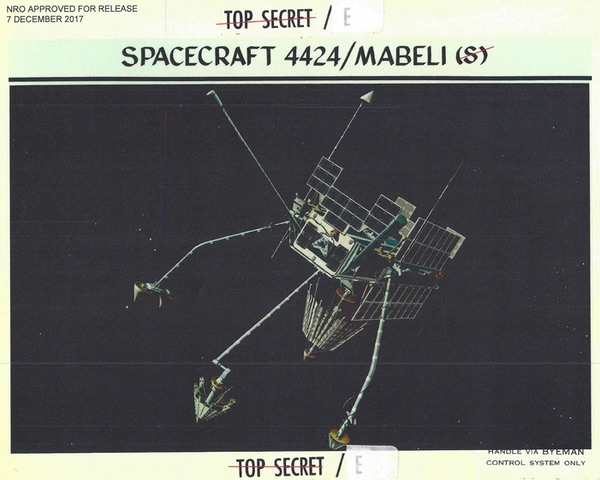Big bird, little bird: chasing Soviet anti-ballistic missile radars in the 1960sby Dwayne A. Day
|
| The satellite had been one part of an often-heated debate over whether the Soviet Union was developing an anti-ballistic missile system, and whether the United States needed one as well. |
MABELI stood for “Main beam TIVOLI.” TIVOLI had been a predecessor satellite, and it stood for “Technical Intelligence Vehicle Orbital Life Indefinite,” which only made a little bit of sense and may have been an inside joke to its designers, who often gave the satellites and their payloads irreverent names, sometimes naming them after movie stars or puns or even their coworkers. Three TIVOLI satellites had flown by 1971, and now MABELI was following on, continuing the mission of listening for signals from Soviet anti-ballistic missile (ABM) radars, a mission that had perplexed American intelligence analysts for much of the 1960s. It had been one part of an often-heated debate over whether the Soviet Union was developing an anti-ballistic missile system, and whether the United States needed one as well.
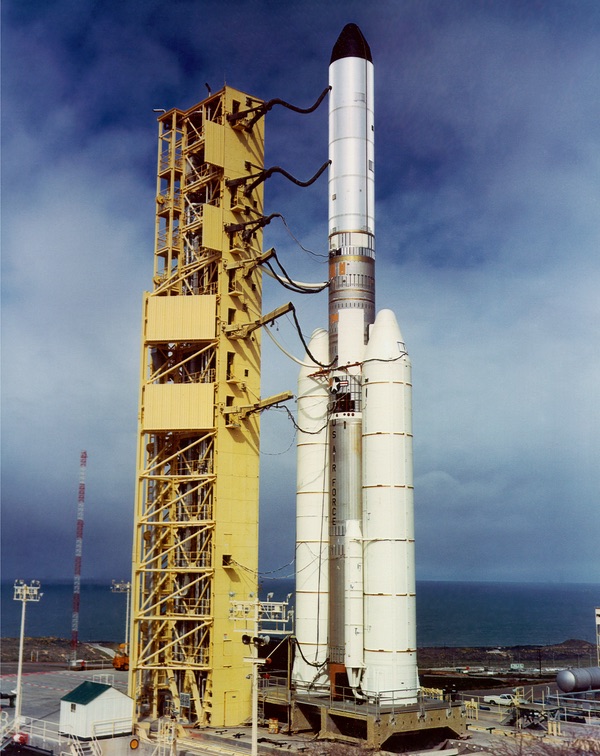 Titan launch vehicle carrying a bus-sized HEXAGON photo-reconnaissance satellite. A rocket similar to this one carried the second HEXAGON into orbit, with the tiny MABELI satellite stuck to its side and deployed in orbit. (credit: Peter Hunter Collection) |
TALLINN
It was the fall of 1966 and Lyndon Johnson was in a bad mood. For more than a year there had been an increasing debate in the senior levels of the US government about the vulnerability of the United States to Soviet ICBM attack, and particularly about whether the Soviet Union was deploying a new anti-ballistic missile system that would defend the Soviet homeland from American counter-attack. For several years, American intelligence had been following the development of an ABM system to protect the Soviet capital of Moscow. In 1963, former Pentagon official Herbert York downplayed reports of Soviet ABM development, which he did not think would work. In response to a question from a skeptical senator about why the Soviets would be spending a lot of money developing a system that was not effective, York replied “Some of their scientists sold them a bill of goods. That happens here too.” Over the next several years, Lyndon Johnson believed it was happening to him.
A new possible ABM system first spotted near Tallinn, Estonia, was gaining greater attention throughout 1966. The CIA had consistently stated that the weapons system, which had been given the overall designation of “TALLINN” even though sites were showing up elsewhere in the Soviet Union, was not for shooting down ballistic missiles but for attacking airplanes. Nevertheless, there were some in the US defense establishment who kept claiming that TALLINN was an ABM system intended to defend the entire USSR from American missiles. In December 1966, a CIA intelligence memorandum stated, “The identification of six new complexes since July provides further evidence that the TALLINN system will be extensively deployed. Three of the new complexes are too far East to receive inputs from known ABM radars; this supports the view that the intended mission of the system is defense against aerodynamic targets. It is estimated that 75 complexes containing 240 launch sites will be deployed by 1971.” (See “An enigma behind the curtain: the Tallinn anti-ballistic missile system and satellite intelligence,” The Space Review, March 18, 2019.) As photographic reconnaissance satellites detected similar sites like the ones mentioned in the CIA memo, the CIA’s analysts concluded that the weapons system that had been labeled “TALLINN” was a “barrier defense system” for protecting the Soviet homeland from planes, not missiles.
| “The president is fed up with the people telling him all these fables about the Soviet ABM program,” Don Hornig, Johnson’s senior science advisor, told NRO Director Alexander Flax. |
Despite the CIA’s conclusion, others inside the US military argued that the TALLINN system could also be used against ballistic missiles, or could at least be eventually upgraded to have an ABM capability. Over the next several years, arguments raged within the intelligence community, the military, and inside the White House, about whether the Soviets were developing a nationwide ABM system that could severely undercut the American strategic deterrent. The evidence that TALLINN could be used to shoot down missiles was thin, but some of the arguments were nevertheless loud. The mere possibility that it could be upgraded from an anti-aircraft system to shoot down ballistic missiles prompted much analysis within the US intelligence community.
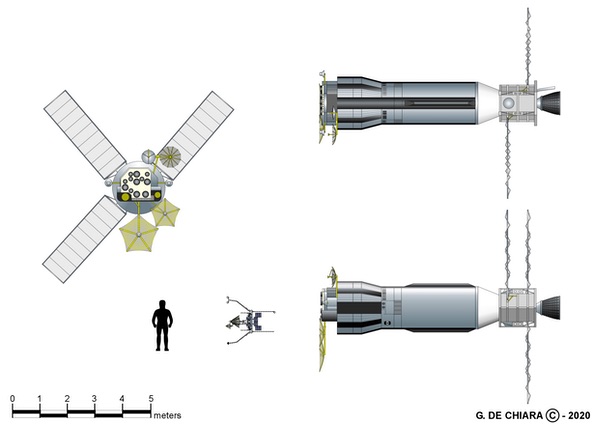 The small MABELI and much larger STRAWMAN satellites. STRAWMAN satellites carried anti-ballistic missile detection sensors into orbit in 1968 and 1969. (credit: Giuseppe De Chiara) |
The NRO responds
Lyndon Johnson was not alarmed by the Moscow system, or evidence of another one around Leningrad. By 1966, it was clear that the Moscow ABM system was still not in operation—Herbert York’s assessment that Soviet scientists had sold their government “a bill of goods” still seemed apt. But Johnson was getting heat from members of Congress about the TALLINN missile deployments, and he wanted the intelligence community to provide better answers. The quickest way to do that was to find Soviet ABM radars and evaluate their capabilities, and so he leaned on the only intelligence agency that could do that, the National Reconnaissance Office (NRO).
“The president is fed up with the people telling him all these fables about the Soviet ABM program,” Don Hornig, Johnson’s senior science advisor, told Alexander Flax, the director of the National Reconnaissance Office. “He’s getting harassed by members of his own party saying they are getting way ahead of us, etc.” The president wanted to put an end to this carping, but he needed solid evidence. Possible Soviet ABM sites were showing up in satellite reconnaissance photos, but their radar signals remained elusive.
Flax had taken the NRO job in fall 1965, and in a 2003 interview he estimated that when he started, signals intelligence was less than 5% of the NRO’s budget. He set a goal of increasing it to 15% by the end of his first year, and by the time he left in early 1969 it was a third of the NRO’s nearly $1 billion annual budget. But in fall 1966, Flax felt that what Johnson was asking for was understandable, but not exactly a good idea. For technical reasons, it was difficult to detect ABM radars. Most of the time they were not turned on, so satellites flying overhead listening for their signals had nothing to hear, and in order to fully characterize them, satellites would have to collect thousands of signals. What Flax wanted to avoid was a directive by Johnson to build a dedicated satellite for detecting the radars. Flax knew that doing so would cost a lot of money and would not appreciably improve the NRO’s ability to detect the signals.
In October 1966, the Committee on Overhead Reconnaissance, known as COMOR, which selected targets to be viewed by American photo and SIGINT satellites, discussed a “requirement for collection against ABM/AES.” AES refers to “Anti-Earth Satellite,” now known as ASATs. By November, the committee discussed this subject again and it became an “urgent requirement for SIGINT satellite collection against Soviet ABM/AES systems.”
A few days later, Director of Central Intelligence Richard Helms wrote a letter to the Deputy Secretary of Defense Cyrus Vance, stating, “On 17 November the United States Intelligence Board (USIB) approved an urgent requirement for information on [Soviet Anti-Ballistic Missile radar and anti-Earth Satellite] systems. It is essential that every effort be made to meet this requirement within the next twelve months. In evaluating the chance of early fulfillment of that requirement, I am convinced that, among the various SIGINT satellite systems presently available, the best hope lies in a concentrated [deleted] program. This program would involve qualitative improvement, as well as an expanded launch schedule, probably to as many as [deleted] per year. I believe that immediate steps should be taken to develop such a program and to make the necessary NRO funds available.”
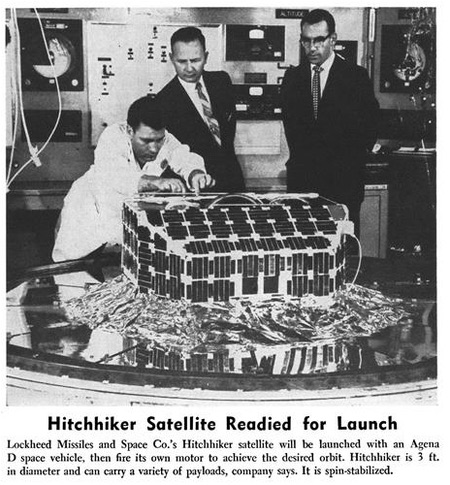 Photo from Aviation Week & Space Technology showing an early predecessor to MABELI. These satellites, first launched in 1963 under the designation Program 11 (later changed to Program 989) were adapted into multiple variants and used for detecting signals. Variants were in operation at least into the 1990s. (credit: Aviation Week) |
By December 1966, a group of senior scientific intelligence advisors to the government met to discuss SIGINT issues. According to a letter by the two senior advisors, Edwin Land and Edward Purcell, “the Panel spent considerable time discussing systems which might meet the urgent requirement to determine the characteristics of the Soviet ABM systems. We believe that the Panel in general would agree that the decisions that would be influenced by the information gathered about these defenses are of such magnitude that we ought not be satisfied with any collection system [deleted more than 25 lines of text].” Land and Purcell were both highly-respected advisers to the government, and although their recommendations remain classified to this day, they would have been taken seriously at the time.
Flax initially chose to deploy more ABM radar detection payloads on NRO signals intelligence satellites already under construction or in development rather than build an entirely new satellite. But Flax understood that the NRO needed a strategic plan for overhead signals intelligence to replace the rather haphazard way that the NRO had been running its signals intelligence program to date. Simply put, despite launching dozens of different signals intelligence satellites and payloads since 1960, the NRO had primarily been chasing targets of opportunity, or even pursuing research and development projects, but not systematically going after the highest priority signals inside the Soviet Union.
| Flax understood that the NRO needed a strategic plan for overhead signals intelligence to replace the rather haphazard way that the NRO had been running its signals intelligence program to date. |
Flax created a committee headed by his deputy, Harry Davis, to develop the strategic plan. That SIGINT strategic plan has not been declassified, but its general conclusions have been declassified: increase the priority for all satellite SIGINT systems, fly more of the BIT satellite vulnerability sensors that were already carried on existing photo-reconnaissance satellites and extend their frequency coverage, build and fly POPPY satellites with greater frequency coverage, improve ground processing to provide real-time data sort by location, and fly five new small satellites specifically targeted for ABM intelligence. These satellites had gone by the designation Program 11, or P-11, early in the decade, but by mid-decade they were apparently redesignated as Program 989 satellites, a designation that covered a wide range of signals intelligence missions, from communications intelligence to the interception of air search radars to the detection and technical characterization of ABM radars.
Throughout the first half of 1967, the controversy over Soviet ABM systems continued. The National Reconnaissance Office was working to provide better intelligence, but this would take time, and it required more money. In July 1967, Flax wrote a memo to the new Deputy Secretary of Defense Paul Nitze, who had just taken over from Cyrus Vance, explaining the status of various satellite reconnaissance programs, including the new signals intelligence systems then under development. “Last November, Mr. Helms wrote to Mr. Vance and requested that, as a matter of the greatest national urgency, increased effort be placed upon collection of SIGINT related to the Soviet Anti-Ballistic Missile/Anti-Earth Satellite (ABM/AES) activities. Dr. Hornig has reiterated that this is a major White House concern. A special committee, headed by Mr. Harry Davis, my technical assistant, and including NRO Staff, CIA, SAFSP [Secretary of the Air Force Special Projects Office] and NSA participation, was formed to consider major new systems. In the meantime, we recommended certain immediate actions on system procurements and operational activities which could be effected during FY67. Based on the Davis Committee report [at least one sentence deleted]. A detailed recommendation on this system will be submitted to ExCom in the next few weeks.”
Flax further explained that the NRO was considering two responses to the “ABM/AES” issue, a lower-cost response and a higher-cost system. The lower-cost response was probably the use of existing Program 989 and POPPY satellites, as well as payloads placed on other satellites, all operating in low Earth orbit. The higher-cost response probably consisted of an entirely new and more ambitious satellite system, the one that the NRO’s Executive Committee was due to evaluate.
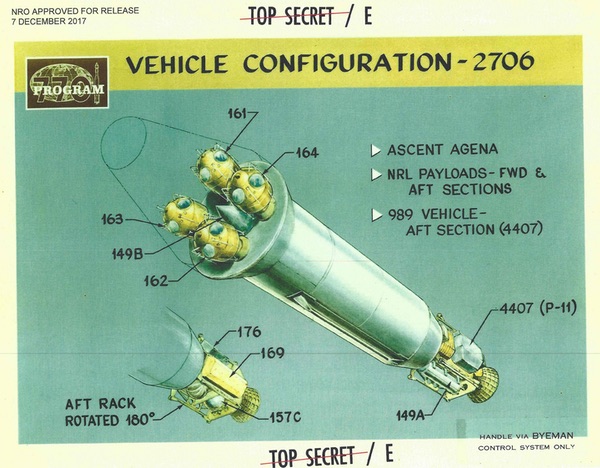 The POPPY 8 mission, launched in September 1969, carried multiple intelligence payloads, including four egg-shaped POPPY satellites under a launch shroud. This mission had a heavy focus on detecting and characterizing Soviet anti-ballistic missile radars. (credit: NRO) |
Deploying the satellites
By 1968, the focus on ABM radars by US satellites had increased. A new signals intelligence payload called CONVOY was developed for an existing class of large signals intelligence satellites that operated in low-Earth orbit. CONVOY was incorporated into the first two STRAWMAN satellites, which entered service starting in 1968. STRAWMAN had other payloads for detecting other types of radars, but the first CONVOY payload was focused on Soviet DOG HOUSE ABM radars that were located around Moscow. The second CONVOY payload was designed to “provide high quality wide band pre-detected data on three frequency agile emitters.” These were the DOG HOUSE, HEN HOUSE, and a third radar emitter still deleted from documents that might have been associated with the TALLINN missile sites that were now sprouting up at various locations throughout the Soviet Union. STRAWMAN also carried other signals detection payloads known as THRESHER and REAPER that focused on other kinds of targets, but also had some ABM radar capability.
Like its predecessors, STRAWMAN launched from Vandenberg on a Thor Agena-D rocket with CASTOR solid rocket boosters. After the Thor’s first stage dropped off over the Pacific, the Agena fired its rocket engine twice, first in its role as second stage for the launch vehicle, then to circularize the satellite’s orbit. After the nose fairing had been jettisoned, the vehicle pitched down 90 degrees and deployed its antennas. Finally, a set of three solar panels deployed from the Agena’s aft rack. The first STRAWMAN launch took place on October 5, 1968. The spacecraft lasted over a year, twice the planned lifetime. STRAWMAN 2, launched on July 31, 1969, operated for more than 13 months.
| One of the justifications for the very high-resolution camera system on the Manned Orbiting Laboratory was that it could provide good images of aerodynamic control surfaces on missiles such as the SA-5, enabling analysts to determine their ability to maneuver at very high altitude and intercept incoming missile reentry vehicles. |
The NRO also began launching the much smaller TIVOLI satellites in January 1968, March 1969, and April 1970, deploying them from the aft end of the Agena spacecraft that supported CORONA and GAMBIT photo-reconnaissance satellites. According to a 1971 memo, 60% of the TIVOLI collection activities were devoted to gathering ABM signals. STRAWMAN’s CONVOY payloads were 100% focused on ABM detection, and their REAPER and THRESHER payloads, which were carried on all five STRAWMAN satellites, devoted 20% of their intelligence collection to ABM targets. According to the same memo, the POPPY series of satellites devoted 70% of their collection activities to ABM radar targets, most likely the POPPY 8 mission launched in September 1969 that included four satellites. Thus, after the late 1966 call to deploy more satellites and systems to hunt for Soviet ABM radar systems, the National Reconnaissance Office had responded with numerous satellites and payloads that had ABM radar detection as one of their primary missions.
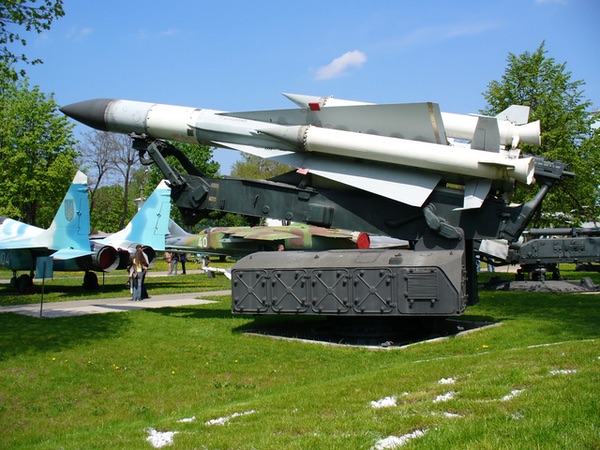 The SA-5 “Gammon” missile was first deployed to a site near Tallinn, Estonia in the mid-1960s. The new system, initially designated “TALLINN” in the West, was the source of considerable controversy within the US government for many years. Although the CIA concluded that TALLINN was a “barrier defense system” for defending against American aircraft, some in the military establishment and elsewhere argued that it could be upgraded to become an ABM. Controversy over TALLINN drove the creation of new payloads for American intelligence satellites to provide better answers about the nature of the Soviet ABM threat. (credit: Wikipedia) |
From Tallinn, Estonia, to Vienna, Austria
Trying to determine the capabilities of the TALLINN system’s missile, which the US intelligence community soon designated the SA-5, became a major intelligence goal during the latter 1960s. One of the justifications for the very high-resolution camera system on the Manned Orbiting Laboratory was that it could provide good images of aerodynamic control surfaces on missiles such as the SA-5, enabling analysts to determine their ability to maneuver at very high altitude and intercept incoming missile reentry vehicles. MOL was canceled in summer 1969.
Claims that TALLINN was a threat to the American ICBM deterrent were often pushed by American military officials and politicians who wanted to deploy an American anti-ballistic missile defense, particularly a system named Nike-X. By summer 1967, Nike-X was canceled in favor of a more limited ABM system named Sentinel. But some in the United States continued to argue that the United States needed an expansive ABM system. In a fire-breathing editorial in June 1969, Aviation Week & Space Technology editor Robert Hotz wrote, “Every senator and congressman should search the depths of his conscience before he votes on this momentous issue. The decision will determine the fate of this country and his children for many years to come.” Ultimately, government officials chose to deploy a limited American ABM system, but its scope was repeatedly scaled back due to cost and questions about its effectiveness.
When Richard Nixon became president in early 1969, one of his goals was engaging in arms control with the Soviet Union. Nixon pursued a Strategic Arms Limitation Treaty with the USSR to limit ABM systems. He and his advisors obviously believed that US intelligence capabilities were sufficient to monitor Soviet compliance with such a treaty. By this time, the TALLINN system and its SA-5 missile were no longer considered as threatening as they had been only a few years earlier.
American intelligence analysts determined that the SA-5 was not an anti-ballistic missile. But there were some within the US military who continued to argue that it could eventually be upgraded to that capability. CIA official Sayre Stevens, who throughout the 1960s had been involved in many assessments of Soviet space and missile systems, later wrote a classified article titled “The SAM Upgrade Blues,” about the debate that raged in the late 1960s concerning the Soviet Union’s ability to upgrade its surface-to-air missiles to engage ballistic missiles. As Stevens explained it, the primary proponents of the argument that Soviet SAMs could be turned into ABMs were “defense technologists,” not members of the intelligence community. He further claimed that the intelligence community had always been convinced that the SA-5/TALLINN sites were for shooting down aircraft, not missiles.
Stevens also wrote that members of the intelligence community believed that the idea of upgrading SAMs to shoot down missiles made no sense, and that any plausible missile upgrades would be extremely limited in effectiveness. Nevertheless, a considerable amount of effort was spent examining possible upgrades to both the SA-5 and the much more well-known SA-2 “Guideline” missile that had shot down Gary Powers’ U-2 spyplane over Siberia in 1960 and was regularly knocking American aircraft out of the sky in Vietnam. The CIA concluded that the SA-2 would be almost useless in an ABM role, but the SA-5 still had sufficient unknowns about it that some people in the US government argued that it was at least a potential threat. This controversy lingered as the United States began negotiating with the Soviet Union over an ABM treaty.
Stevens was involved in Strategic Arms Limitation Treaty discussions carried out in Vienna, Austria, and in June 1970 found himself at the American embassy there when the subject of SAM upgrades came up. As Stevens explained, after the formal discussions, the two sides would retire for refreshments—vodka and caviar when they met at the Soviet embassy, and bourbon and peanuts at the American embassy.
| “The Soviet generals were tough birds,” Stevens remembered. “Gryzlov, a former head of the GRU, not only looked like a horror-movie principal, but hovered in the background much as a military conscience to the delegation.” |
At the meeting Stevens attended, the SAM upgrade question finally came to a head. The Soviets, Stevens said, stated that SAM upgrade was “an extraneous matter the U.S. was introducing to complicate the negotiations.” After the tense discussion had ended, various groups were mingling in the embassy, drinking and engaging in informal discussions. “In one such group, Lt. General Royal Allison of our Air Force was conferring with Col. General N. M. Alekseyev and Col. General A. A. Gryzlov, both of the Soviet General Staff, and Minister P. S. Pleshakov of the Ministry of the Radio Industry on the matter of SAM upgrade,” Stevens recounted. “Pleshakov (whose ministry had built the Soviets' huge ABM radars) was arguing that SAM upgrade was not feasible. Allison countered by insisting that if this were so the Soviets should have no objections to accepting a prohibition on SAM upgrade. The Soviets insisted that since it was not feasible no prohibition was necessary. Allison pointed out that he wasn't so sure it couldn't be done and finally called upon the Soviets to tell us in forthright fashion about the capabilities of the Tallinn (SA-5) system if they really wanted to allay our fears about this matter.”
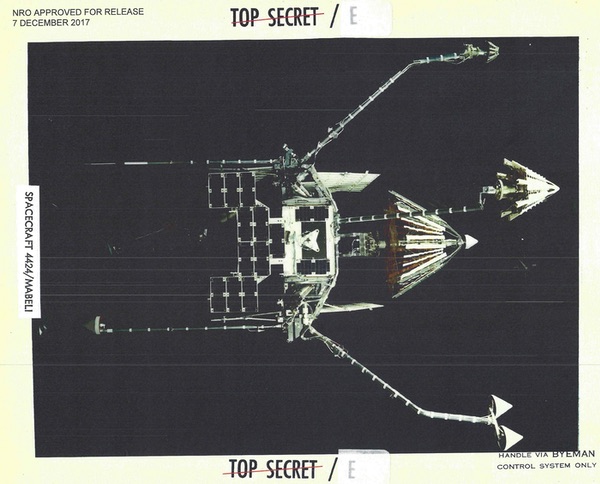 Declassified image of MABELI satellite. Like other members of the Program 989 satellite family, MABELI was covered in antennas. (credit: NRO) |
The bitter battles that had been taking place within the senior levels of the US intelligence and defense communities over SAM upgrades were now being played out between Soviet and US officials in the American embassy in Vienna. Lubricated by American bourbon.
“The Soviet generals were tough birds,” Stevens remembered. “Gryzlov, a former head of the GRU, not only looked like a horror-movie principal, but hovered in the background much as a military conscience to the delegation. The Soviets had said almost nothing about their weapons, and had taken pleasure in our obvious discomfiture about the SA-5. The Soviets continued to evade, but Allison persisted. Alekseyev, the senior military delegate then in Vienna, at long last shot a look at Gryzlov, gulped visibly, and answered that the Tallinn System was an air defense system like Nike-Hercules or Hawk, and that if it were to be used in an ABM role, virtually all its components, including missile and radar, would have to be replaced.”
This was, in fact, what the CIA had been telling American officials for years.
“Standing on the edges of this conversation, I somehow saw a whole life of battles about the capabilities of the SA-5 system and the possibilities of SAM upgrade flash before my eyes,” Stevens recalled. “Though I returned to further battles on both issues, I somehow felt more relaxed about it all.”
The ABM treaty was eventually signed in spring 1972. Thus, by the time tiny MABELI popped off the side of the big HEXAGON satellite in January 1972, the pressure to find and characterize Soviet ABM radar signals had eased considerably. The satellites’ primary role now was to monitor Soviet treaty compliance, as well as to determine possible countermeasures to enable American missiles to penetrate the existing, limited ABM defenses.
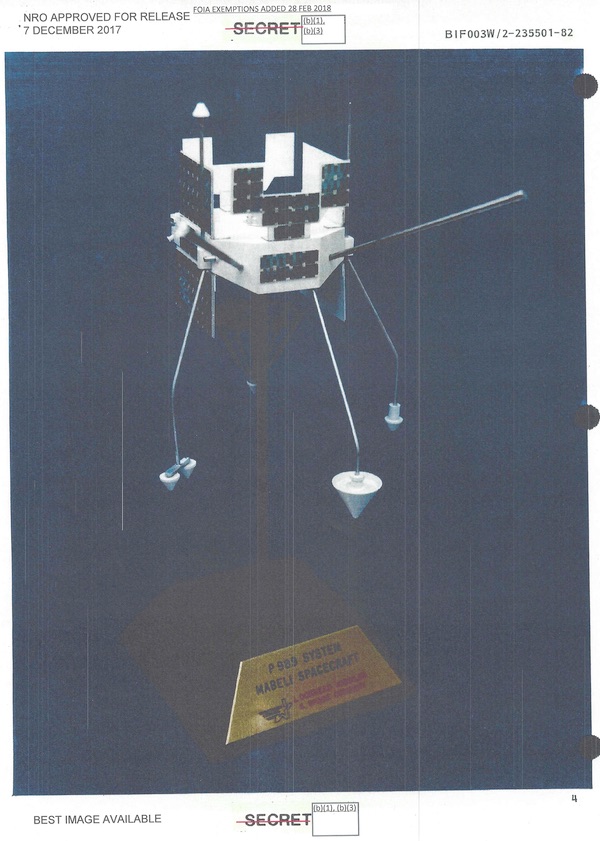 Top secret contractor model of the MABELI satellite. (credit: NRO) |
Program 989
A photograph of a contractor’s model of the MABELI spacecraft indicates it was part of Program 989, which probably also encompassed the earlier TIVOLI satellites as well. The SIGINT strategic plan created by Harry Davis’s committee in late 1966/early 1967 had called for five new small satellites devoted to ABM detection. The three TIVOLI satellites and MABELI add up to four satellites. It is possible that a fifth satellite was canceled as the ABM threat receded, or the capabilities were incorporated into another satellite.
MABELI was still operating 11 months after launch, but it is unknown based on existing sources when the little satellite finally ceased operating. It suffered from degraded sensitivity in one of its receivers, but whether this was a problem from the start of the mission or happened after several months in orbit is also unclear. MABELI was a small bird, and it still retains its mysteries. But by the time it was flying, there was already a new satellite in orbit, much bigger, and undoubtedly more capable—the higher-cost option that the NRO was evaluating in summer of 1967. That satellite, known as JUMPSEAT, will be the subject of another article.
Note: we are temporarily moderating all comments submitted to deal with a surge in spam.
